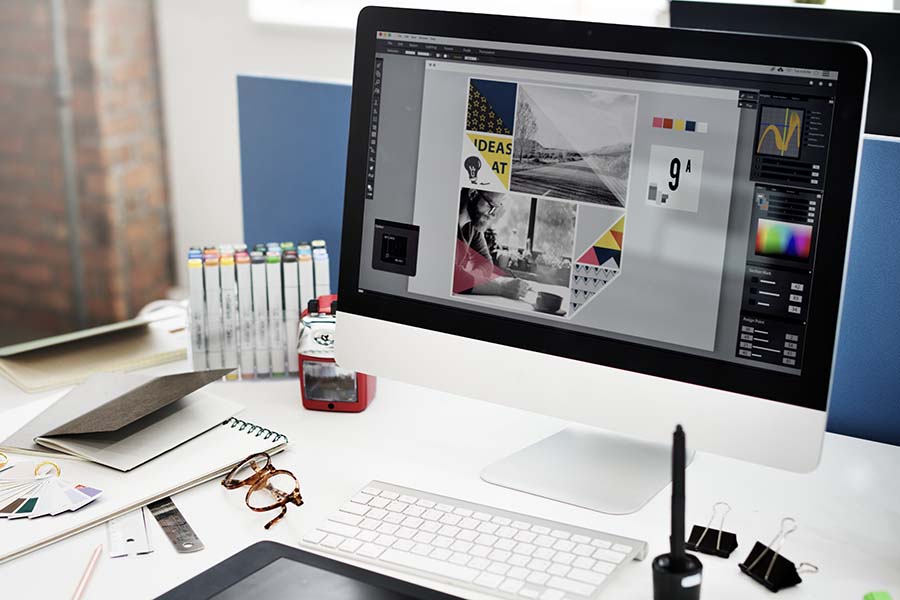Digital Design: Future Trends & Predictions

In today’s rapidly evolving digital landscape, staying ahead of the curve is crucial for businesses and designers alike. The digital design world is constantly evolving, and keeping an eye on the latest trends and predictions is essential to ensure success in this field. In this blog, we will explore the future of digital design and highlight some key predictions and trends to watch out for.
The Rise of Artificial Intelligence (AI) in Design
Artificial Intelligence (AI) has already significantly impacted various industries, and it is also set to revolutionise the design field. AI-powered design tools are becoming increasingly prevalent, allowing designers to automate repetitive tasks, generate design suggestions, and predict user behaviour.
With AI, designers can leverage machine learning algorithms to analyse vast data and gain valuable insights into user preferences and trends. This information can be used to create personalised and highly targeted designs that resonate with users more deeply.
AI-powered design tools automate repetitive tasks, saving designers time and effort.
Machine learning algorithms analyse data to provide valuable insights for creating personalised designs.
Predicting user behaviour allows designers to optimise design elements for maximum impact.
The Growing Importance of User Experience (UX) Design
User Experience (UX) design has always been a critical aspect of digital design, and its significance is expected to grow. As technology advances and user expectations rise, designers must prioritise creating seamless and intuitive user experiences across all digital platforms.
Incorporating UX design principles into the entire design process will become even more crucial, as designers must consider factors such as usability, accessibility, and inclusivity. By delivering exceptional user experiences, businesses can enhance customer satisfaction, increase engagement, and drive conversions.
UX design principles ensure that digital platforms are user-friendly and intuitive.
Considerations like usability, accessibility, and inclusivity contribute to a positive user experience.
Exceptional user experiences lead to increased customer satisfaction, engagement, and conversions.
Minimalism and Simplified Design
In recent years, we have witnessed a shift towards minimalistic and simplified design aesthetics. Clean lines, ample whitespace, and thoughtful typography have become the hallmarks of many successful digital designs. This trend will continue as users increasingly value simplicity and clarity in their digital interactions.
The minimalistic design creates a visually appealing experience and improves usability by reducing cognitive load and enhancing content readability. By stripping away unnecessary elements and focusing on essential information, designers can create visually appealing and highly functional designs.
Minimalistic design aesthetics with clean lines and whitespace create a visually appealing experience.
Thoughtful typography enhances content readability and user engagement.
Reducing cognitive load improves usability and ensures a seamless user experience.
Responsive and Adaptive Design
With the ever-increasing variety of devices and screen sizes, responsive and adaptive design has become necessary for digital designers. The future of digital design lies in creating designs that seamlessly adapt to different devices, ensuring a consistent and optimal user experience across platforms.
Responsive design involves designing layouts that automatically adjust and respond to different screen sizes, enabling users to access content on smartphones, tablets, and desktops without any usability issues. On the other hand, adaptive design takes customisation a step further by tailoring the design based on the specific device characteristics and capabilities.
Responsive design ensures that content is accessible and user-friendly across different devices.
Design layouts automatically adjust to different screen sizes for optimal user experience.
Adaptive design customises the design based on specific device characteristics, further enhancing usability.
Immersive and Interactive Design Experiences
Designers are exploring new ways to create immersive and interactive design experiences as technology advances. Virtual Reality (VR) and Augmented Reality (AR) technologies have gained significant traction, allowing designers to create memorable and engaging user experiences.
By leveraging VR and AR, designers can transport users into virtual worlds, allowing them to interact with products, services, or information in exciting and dynamic ways. These immersive experiences not only captivate users but also have the potential to drive greater engagement and create lasting brand impressions.
VR and AR technologies create immersive and interactive experiences for users.
Users can interact with products, services, or information in exciting and dynamic ways.
Immersive experiences captivate users, drive engagement, and leave lasting brand impressions.
Emphasis on Accessibility and Inclusivity
Inclusivity and accessibility are becoming increasingly important in the world of digital design. Designers must consider the diverse needs of users, including those with disabilities, and create designs that are inclusive and accessible to all.
Designing for accessibility involves ensuring that digital experiences can be easily used by individuals with disabilities, such as visual impairments or mobility limitations. This includes considerations such as proper colour contrast, alternative text for images, and keyboard navigation options. By incorporating accessibility principles into design, businesses can reach a wider audience and demonstrate their commitment to inclusivity.
Designing for accessibility ensures that individuals with disabilities can easily use digital platforms.
Considerations such as colour contrast and alternative text for images improve accessibility.
Keyboard navigation options facilitate easy navigation for users with mobility limitations.
Conclusion
The future of digital design is filled with exciting possibilities and opportunities. By embracing emerging technologies, prioritising user experience, and staying attuned to the latest trends, designers can create compelling, impactful designs that resonate with users.
As AI advances, designers can leverage its capabilities to enhance their design process and create personalised experiences. Minimalistic and simplified design aesthetics will continue to dominate as users appreciate clarity and simplicity in their digital interactions. Responsive and adaptive design will be crucial to ensure seamless experiences across devices, while immersive and interactive design experiences will captivate users like never before.
Lastly, designers must prioritise accessibility and inclusivity, ensuring that their designs are usable by individuals with diverse needs. By embracing these predictions and trends, designers can successfully navigate the future of digital design and create designs that leave a lasting impact.
Be sure to check out our other related posts if you enjoyed this one:
- Unlock Your Genius: Top Tech Tools on Amazon for Ultimate Creativity!
- Level Up Your Digital Design: Gamification Secrets
- Mastering Social Media: Engaging Content Tips
- Mastering Email Campaigns: Tips for Success
- Revolutionising Digital Design: The AI Impact
- Colour Psychology: Unleashing Design’s Emotional Power
- Discover the Top NFT Marketplaces for Selling Your Digital Art
- Top 10 Touchscreen Drawing Tablets: Find the Best One for Your Artistic Needs
Sign up for updates on this blog and our latest business posts if you enjoyed reading this one.
Share our blog content with your friends and colleagues via Facebook, Twitter, Pinterest, LinkedIn, email or WhatsApp links below and help them stay informed about the latest insights on business, marketing, finance, lifestyle, and society. Let’s build a knowledge-sharing community and empower each other to achieve our goals.
FAQ
How can AI-powered design tools benefit designers?
AI-powered design tools automate repetitive tasks, saving designers time and effort.
Why is user experience (UX) design necessary in digital design?
UX design principles ensure that digital platforms are user-friendly and intuitive.
What are the benefits of minimalistic and simplified design aesthetics?
Minimalistic design aesthetics with clean lines and whitespace create a visually appealing experience.
Why is responsive and adaptive design important in digital design?
Responsive design ensures that content is accessible and user-friendly across different devices.
Credits
Featured image by rawpixel.com on Freepik.









